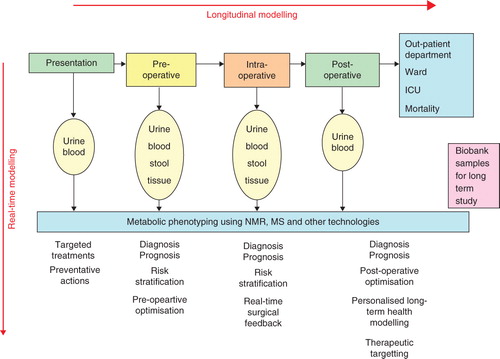Figures & data
Figure 1. The first exemplification of the pharmacometabonomics concept based on pre-dose prediction of toxicity in an animal model. (Top) Typical 1H NMR spectrum of urine before dosing with the toxin galactosamine. (Bottom) A principal components scores plot where each point represents a single rat urine taken before dosing. Red indicates rats that subsequently showed high toxicity and green points are for rats that showed no toxicity. Although there is a partial overlap between the two groups of animals, a clear distinction is observed Citation[4].
![Figure 1. The first exemplification of the pharmacometabonomics concept based on pre-dose prediction of toxicity in an animal model. (Top) Typical 1H NMR spectrum of urine before dosing with the toxin galactosamine. (Bottom) A principal components scores plot where each point represents a single rat urine taken before dosing. Red indicates rats that subsequently showed high toxicity and green points are for rats that showed no toxicity. Although there is a partial overlap between the two groups of animals, a clear distinction is observed Citation[4].](/cms/asset/dbb2289e-28c1-460c-b310-45be36cfa9d8/iemt_a_11103357_f0001_b.jpg)
Figure 2. A schematic diagram indicating how longitudinal pharmacometabonomics could be used to monitor and stratify patients who are undergoing surgery. Samples can be taken at all stages of patient treatment and used to provide metabolic trajectory information, i.e., the changes in metabolic profiles over time can be used to predict patient outcome and to guide the physician and surgeon. The patient's metabolic trajectory will reflect the combined effects of disease progression and clinical therapy. Both short-term stratification and risk assessment are possible and also, in principle, long-term patient management. Finally, samples can be biobanked so as to build up a large collection suitable for epidemiological study.
